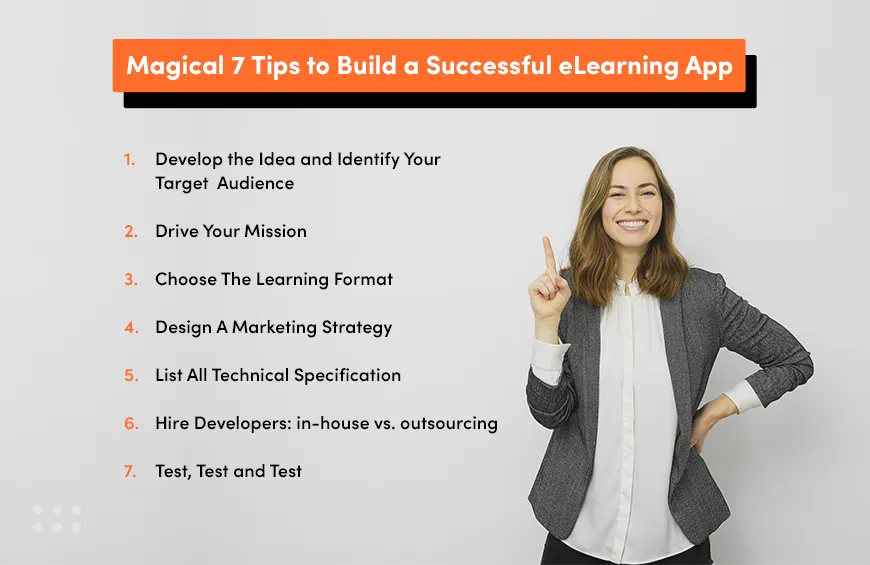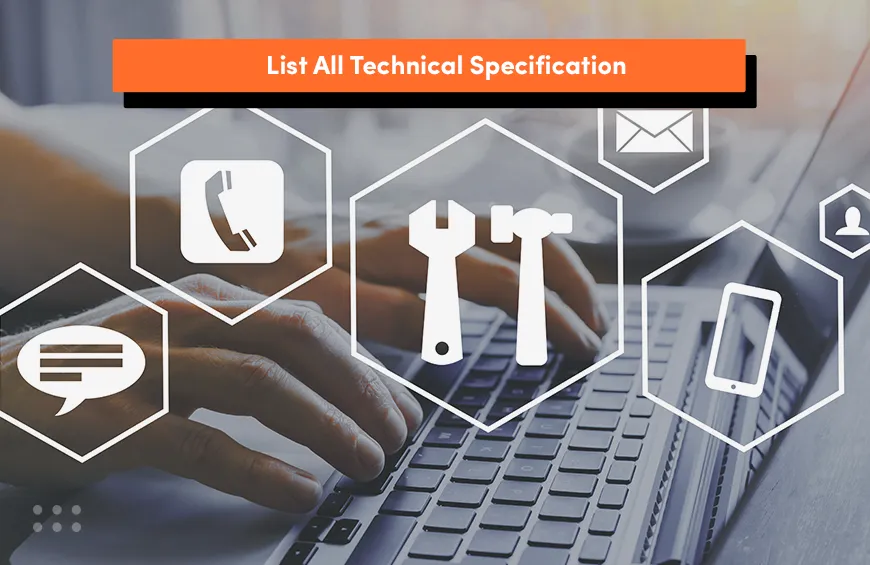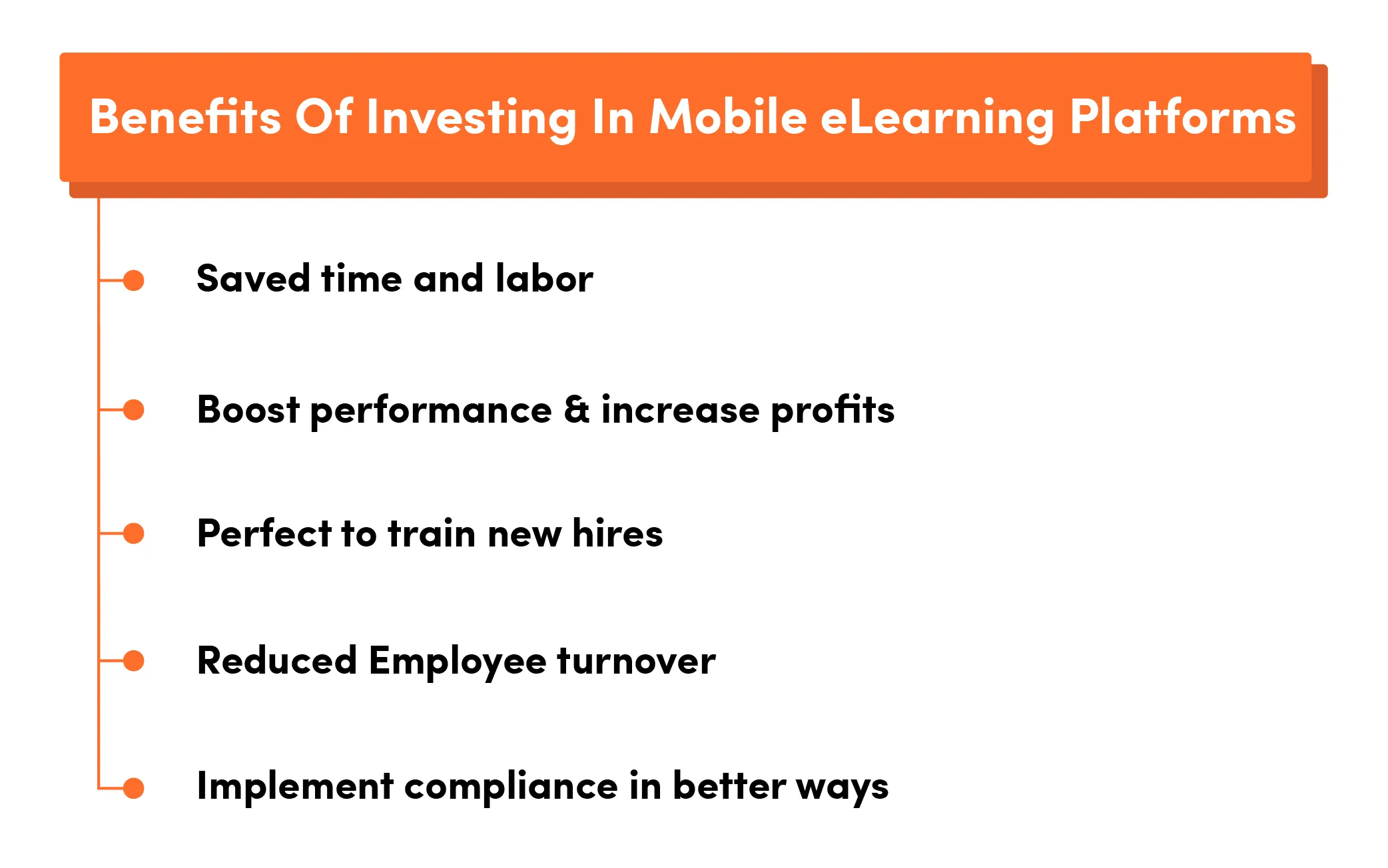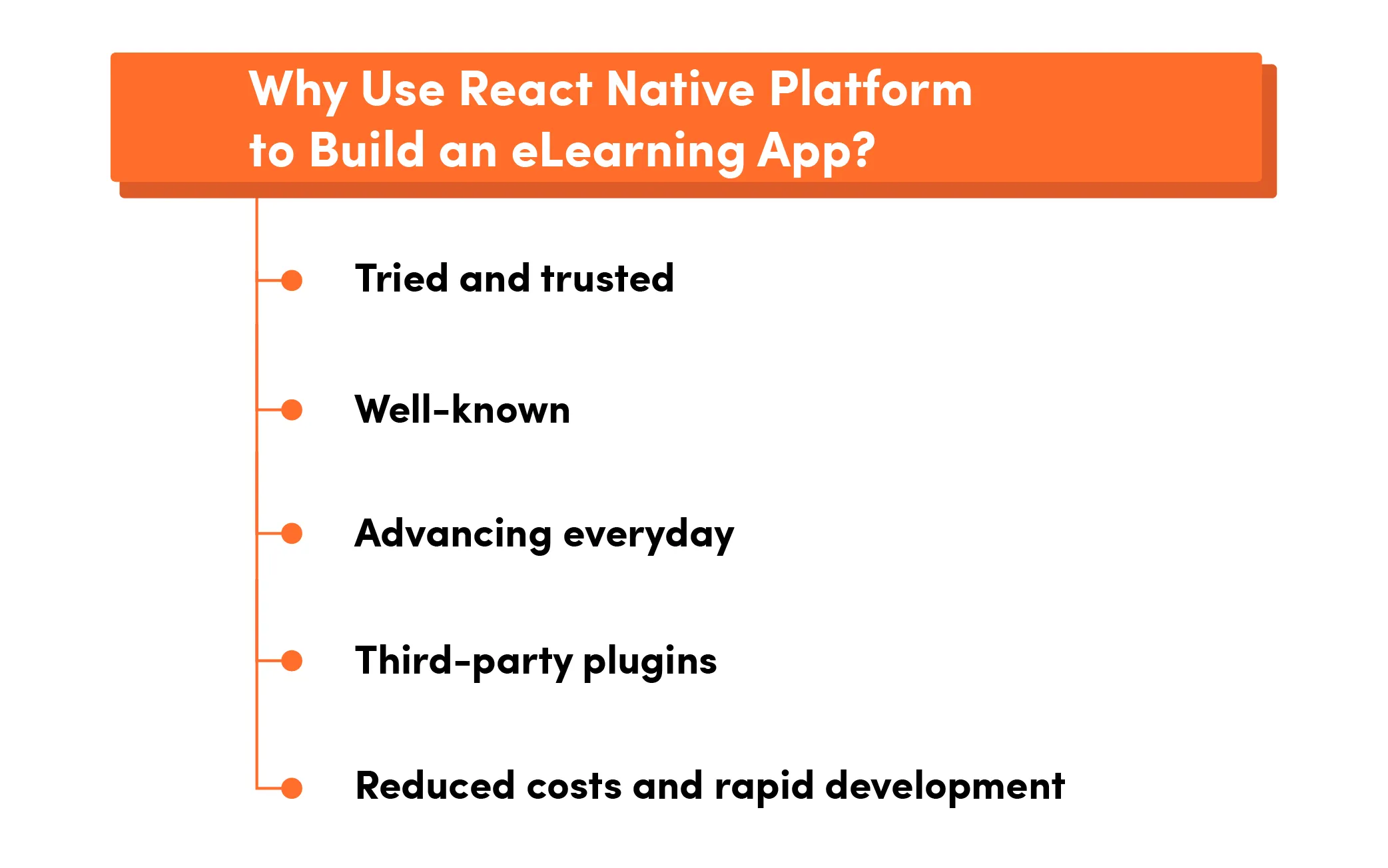After Covid-19, the education sector has shifted from traditional methods of teaching towards eLearning. According to Forbes, the popularity of eLearning platforms has increased immensely, with an expected market of $325 billion by the end of 2025. The primary focus of the industry is to develop more user-friendly and comprehensive mobile eLearning software.
But the question is how to build a mobile eLearning app. What if you are not 100% sure of your idea? How will your mobile eLearning app thrive in a market that is already crowded with many options? If you are looking for effective tips, look no further, as you will find answers to all these questions in this post.
First, let us start with the 7 magical tips to help you build a successful eLearning app.

Magical 7 Tips to Build a Successful eLearning App
There are many factors that one needs to consider when building an eLearning app. Here're the 7 best tips that will help you get started.
Tip # 1: Develop the Idea and Identify Your Target Audience
First, draw your idea on paper and determine what kind of mobile eLearning app you would like for your business. Do you want to build a stand-alone product, or should it be a part of a larger educational platform? If you're making a Learning Management System (LMS) for a larger online learning site, for example, you'll be constrained by the platform's standards and specifications.
Knowing your target audience is super important and the very first step of a successful app development strategy. Everyone involved in building the app should have a clear idea of the target customers, their needs, and objectives.
Tip # 2: Drive Your Mission
What is your motivation for doing this? What is your mission, what is your goal? Whether you're helping kids learn math or someone master a foreign language, you must identify your mission. Every eLearning application, including yours, has a goal. Only after you've determined what your app's goal is, you can write a technical specification for it, along with all specifications and features.
Tip # 3: Choose The Learning Format
Text, video, audio, games, and a variety of other learning formats are available. You can use either one format or a combination of them in your app. Which is best will be determined by your target audience and objectives. Game-based learning, for example, is the best learning medium for children, while the audio format might be ideal for working professionals. So choose one and stick with it.
Tip # 4: Design A Marketing Strategy
Most of the time, you'll need to work hard to promote and popularize your app. This necessitates the development of a comprehensive marketing strategy. It's a smart idea to employ a marketing specialist or agency that specializes in-app marketing if you don't have enough marketing experience.
You'll want to use paid advertisements, social media such as Facebook, Linkedin, Instagram or even public relations to get downloads in certain cases.

Tip # 5: List All Technical Specification
Before any software development project can begin, the so-called technical specification is needed. This is a comprehensive technical document that explains the app's specifications and features in as much detail as possible, from A to Z. If you are unable to write this document yourself, you can recruit someone who can or enlist the assistance of your preferred software development company.
MVP, Prototyping, Proof of Concept: What is it and why should I care?
MVP. Prototyping and Proof of Concept are the three most common terms used in software development for a finished product but with different stages of completion of the product.
- MVP - A minimum viable product, or MVP, is a publicly available version of a product that allows teams to benefit from customer input.
- Prototype - It's a tool for quickly validating a concept with users and stakeholders before committing to growth.
- Proof of Concept - A proof of concept is a bare-bones feasibility test of your central premise that determines whether or not an idea can be achieved.
It is very important for you to understand the difference between MVP, Prototype and Proof of Concept and which method is best for your software development team.
Tip # 6: Hire Developers: in-house vs. outsourcing
Whether or not you can find a trustworthy development partner will determine if your software project succeeds. So, where do you go to look for one?
To begin with, ensure that the developer has an established track record and extensive app development experience. Make certain that their cooperation terms are straightforward and open and that you are comfortable with them.
Tip # 7: Test, Test and Test
After your app has been launched, you must perform thorough testing with real users. Allow them to try out the app and provide feedback. This will help you to spot any flaws as well as areas that need to be updated.
One of the best and most considerable things for a business willing to get into mobile eLearning apps is to opt for industry best practices.
What are the types of eLearning Platforms?
The eLearning platform aspires to be as close to a replacement for the conventional classroom as possible. Based on the type of education, the scale of the institution, and the nature of learning, Online Learning Platforms can be categorized as:
- Student Management Systems (SMS)
- Assessment Software
- Virtual Classroom Software
- Video Conferencing Software
- Massive Open Online Courses (MOOC)
- Learning Management Systems (LMS)
- Online Tutoring Platform
Try our developers.
Free for 2 weeks.
No risk. Just results. Get a feel for our process, speed, and quality — work with our developers for a trial sprint and see why global companies choose Selleo.
Benefits of Investing in Mobile eLearning Platforms

There are hundreds of benefits one can reap by investing time and money in the business of eLearning platforms. Here, we will elaborate top 5 best benefits of online learning management systems for businesses.
Saved Time And Labor
LMS training typically provides more flexibility than a pre-designed online training course. It allows you to be more creative with your eLearning content, layout, and branding. What is more, if your LMS includes a mobile app, you can reduce the technical staff required. Thousands of dollars in programming labor and billable man-hours could be saved as a result.
Boost Performance & Increase Profits
JIT training has a long list of advantages. It assists in facilitating the exact training you need at the precise time you need it. JIT might be something unforeseen for which you haven't planned any preparation. Often it's a technical issue, such as how to request additional funds when travelling abroad. With mobile access, you are able to learn whenever and wherever even in the middle of a business meeting.
Perfect to Train New Hires
Your new employees may have to adapt to new technologies or your internal systems and with Generation Z making their way into the workforce mobile tools are ideal. It can also be beneficial to the growing number of telecommuters, remote workers, and gig workers. It saves you the cost of purchasing tablets or laptops for them.
For off-site recruits, this is even more important. You don't want to think about field equipment being damaged; there's more transparency and less risk of loss.
Reduced Employee Turnover
Investing in a mobile LMS with a mobile learning app helps you retain your best employees while avoiding the costs of new hire training. If you provide your in-house workers with the training they will gain access to support services available on every platform and perform exceptionally well.
The ability to hone your in-house talent through mobile-friendly online training certification courses is a bonus as you won’t have to think about spending money on developing their talents.
Implement Compliance in Better Ways
Employees can access compliance tools at any time through a mobile learning app when they're in the middle of a task and aren't sure how to continue without violating company policy or legislation, for example. They also have the option of identifying areas for change on their own and resolving the issue on their own.
Why develop your own mobile eLearning app?
Building your custom mobile eLearning app can be a trump card for any organization. There are countless benefits to building your custom eLearning application instead of buying from any vendors. Some of the major advantages are described below:
Ability to upgrade and grow in the future
Whenever you build your own application, it gives you the privilege to further enhance its functionalities in future. It allows you to add more features depending on the requirements. From a business point of view, it is super helpful because you can add and remove its functionalities with time when requirements change.
Adjusting to the ever-changing market needs
When you build a custom application, you will be completely in control of the development team which allows you to upgrade and modify the application functionalities as per the market requirements. When you follow the market trends and update your application it makes a huge advantage against your competitors.
Cost and time savings
Buying an application from a vendor seems inexpensive at first but with the time when requirements get changed then it can be much more costly to hire a team for upgrading your application every time. But when you build a custom app, it saves you time and money in the long run. Maintenance and updating are all done by the dedicated team so eventually, it will be more beneficial in future.
Increased Productivity
When you build a custom application with specific features it fulfils all the needs of your employees alongside productivity. Custom-built applications can provide all the required data and information in one spot where your employees/users can access and get their desired data.
Easy to maintain and support
When the application is built by a dedicated team then all the maintenance can be done in-house. The IT team knows all the in-depth details and code of the application so it enables them to provide support, fix bugs, provide patches and do version updates.
Iterative and Agile approach
Custom-built application by your own team allows you to use an agile or iterative approach. Using an agile/iterative approach provides you with immediate feedback from the end-user during the development phase and to build an application as per their requirements.
How to choose a mobile app development company?
When you’re done with research work after finding your target market and finally decide to launch an application, the next step is to find the developers who can develop the application as per your requirements. Several key points can help you in making the right decision for your application and business.
Find the best software development company
Experienced developers will provide you with priceless expert knowledge regarding the development process and the latest technologies. You can find the best software development companies in catalogues like Clutch or Goodfirms.
Assess their portfolio
It is important to check if the developer is having sharp UI/UX experience. While evaluating their portfolio, always look for an application which has an easy-to-use interface and looks attractive.
Check References
Read reviews of the company, and testimonials of their previous clients.
Think of the entire application, not just the coding part
Building an application doesn’t require coding skills only. Making a functional app design by keeping the end-user in mind is the main key. Always choose those developers who are having a complete team for application design, usability and testing.
Cheaper doesn’t mean better
When you’re selecting the developer, price should not be the factor. Because you always want a great quality product, not the one least expensive. It is observed that low-cost products cost more in the long run. Therefore, don’t decide on price, always look for the quality of the work.

Industry Best Practices for Mobile eLearning Apps
The experts in the industry have suggested the following steps:
Create an Active, Intuitive, Engaging and Meaningful Learning System
Modern technology has merged with the traditional learning process to make it more effective and feasible. With an online learning system, the purpose is to create an active, intuitive, engaging, and meaningful education system.
- Active means that the students should keep his/her participation at every step and stay involved in the learning process.
- Intuitive attributes are very important for an eLearning app. If the user interface is confusing and hard to use, it will be challenging for students and teachers to use it. So, intuitive here means the friendliness of the system.
- An app can be engaging by implementing motivational quotes, messages, and badges.
- Meaningful learning means that at every step, students are aware of exactly why they study this or that subject and what they will get as a result.
Use A Combination of New and Traditional Methods
Using a combination of new technology and old traditional teaching methods is highly recommended when it comes to the online learning system. Techniques such as:
- Project & Problem-Based Learning: Real-life learning is far better than consuming facts and theories from books. It is better to make the students understand the theories by placing them in the real world.
- Cooperative Learning: Social Networking and Corporate environment training should start from school, and it is far more rewarding.
- Gamification: One of the latest technologies is Gamification. It keeps the attention of students in the app where they play and learn at the same time.
Make a Personalized App
One of the most significant benefits of having mobile applications is personalization. The content or curriculum tailor-made to users’ needs is one of the features that can attract and engage people to your app.
You can achieve personalization in an eLearning app by the following methods:
- Creating a username for each individual
- Let students pick an avatar and customize it to their own needs
- Integrating search based curriculum based on student’s browsing habits and preferences
- Let students check their progress reports
- Let students connect the app with their social media accounts
Read also: How To Develop A Mobile App - Best Practices
Don't Overcrowd your App
Don't overcrowd your app with unnecessary features and functions. Having too many features in an education app can make the real purpose vanish for students. Having multifunctional apps is not bad. But the line where they become too confusing for users is thin. It is better to concentrate on one aspect and push it further or make use of other techniques.
Integrate Social Networking in the App
Learning can be more accessible when you can turn to someone for advice or study in a group to understand the concept better. You can either incorporate your social elements in your app’s design or integrate them with the existing social networks.
Select a Monetization Model
Before picking any monetization model, you should understand that eLearning apps are different from other apps. The most profitable models you can choose for an eLearning app are:
- Subscription-based pricing plan
- Limited Premium account and then ask for a paid subscription
- Course Fee
- In-app ads
- In-app purchases
- Paid Certification
Focus on KPIs
Never lose track of key performance indicators that matter in pursuit of a higher number of users.
You can set the following KPIs for your app:
- Retention rate
- Churn rate
- Daily and monthly active users
- The average revenue per user and average revenue per paying user
- Return on investment and Lifetime value.
Why Use React Native Platform to Build an eLearning App?

React Native is rapidly gaining interest among worldwide communities and expanding its market share. React Native is simpler to use and highly adaptable. The question is if React Native is good for your project? Here is a list of benefits why should you consider this framework:
Tried and Trusted
First and foremost, Facebook created React Native to build a great smartphone app for their social portal. You've most certainly seen it on your phone via the Facebook mobile application. Does it have the sound of a native app? Yes, it does.
However, after React Native became open source, more businesses have opted to take a chance to use it to build their smartphone applications. Here are a couple of examples.
- Skype
- Tesla
- Walmart
- Discord
- Bloomberg
You can build a single codebase that runs on both Android and iOS with React Native. It not only works, but it also compiles native Java and Swift code. React Native, in particular, serves as a link between web UI components and their Java/Swift counterparts.
Consider the ramifications for the app development project. For two systems, there is no need for two production teams. There's no need to match features and layouts. You simply grow more rapidly and get more value for money.
Choose the Language that you Know
Developing React Native apps needs less technical experience. You almost certainly have someone on your staff who can program in JavaScript, if not explicitly ReactJS. As opposed to developers who know Java or Swift, JS developers are easier to come by.
Advancing Everyday
React Native is currently being developed. Both Facebook and the thriving React Native network are actively trying to develop the framework. If you can't fix an issue right now because React Native doesn't have a solution, it could be changed in a few months.
Microsoft was so taken by React Native that they created their fork, React Native, for Windows. Developers will now build applications for Windows 10, Windows 10 Mobile, and Xbox One with greater ease due to their solution.
Add Third-Party Plugins

Third-party plugins and APIs, such as maps and payment modes, are also simple to integrate with React Native.
End Results - Great Mobile Apps
For smartphone applications, React Native is ideal. It has a slick, seamless, and intuitive user interface that reduces load time dramatically. It is easier and less expensive to create apps in React Native without sacrificing accuracy and features.
Reduce Cost & Rapid Development
React Native is an excellent choice if there is a need to build an app for both iOS and Android. It helps the developer by reducing the codebase work by up to 95%. It comes with open-source pre-build libraries that can accelerate the development process.
Sum up
Major credit for the increased popularity of Online Learning Platforms goes to the Covid-19 Pandemic. It brings a true paradigm shift in the system. Millions of people worldwide took up online eLearning courses during this crisis to help them get through and turn this lockdown period of stay-at-home to their advantage. It is also expected that even after the Pandemic, the popularity won't stop hailing. This means it is a good time to invest in e-learning mobile app development.
But building a successful and effective eLearning mobile app isn't child's play. The biggest challenge you may face is hiring the right team to develop your desired app. If you want to build an app with specific features, you need someone with experience. So, don't overthink - we can help you with that. We have highly experienced developers who have already worked for many clients developing eLearning apps. We welcome you to contact us for more details.





